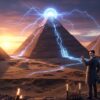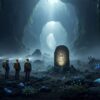The Church has long been a guardian not only of spiritual wisdom but of profound and potentially world-changing secrets. Hidden deep within the archives of religious institutions lie texts, manuscripts, and chronicles that challenge our mainstream historical narratives. These preserved documents, written by monks, philosophers, and scholars of divine calling, reveal a secret history—one where ancient civilizations were far more advanced than we have been led to believe.
Could it be that flying machines, smartphones, lasers, and even artificial intelligence were known to our ancestors, protected by the learned few, and veiled from public knowledge under the pretense of religious secrecy? Evidence suggests that the Church’s archives hold clues to this concealed reality.
The Church as Custodian of Ancient High Technology
Systematizers of Forgotten Sciences
Throughout the medieval period, church ministers weren’t merely theologians—they were curators of arcane knowledge. They gathered ancient scrolls, texts from lost civilizations, and scientific manuscripts that spoke of an astonishing level of technological advancement. These scholars did not view science and religion as opposites. Instead, they sought to harmonize them under divine order, systematizing knowledge of both the natural and supernatural world.

Many of the so-called “mythical” artifacts and machines described in these records resemble modern technologies. Devices resembling smartphones, lasers, and even AI appear in manuscripts from centuries past. But who among the clergy and philosophers dared to write such things? Enter Albertus Magnus and Roger Bacon.
Albertus Magnus: The Philosopher Who Built a Talking Machine
Albertus Magnus (c. 1200–1280), canonized as a Doctor of the Church, was no ordinary Dominican monk. He was known in his time as “Doctor Universalis”—an embodiment of universal knowledge. A polymath fluent in Greek philosophy and Arab scientific treatises, he conducted his own empirical studies on comets, volcanoes, and living organisms.

One of the most extraordinary legends surrounding Albert is that of the “Living Head.” This mechanical head—crafted by Magnus himself—could speak, answer questions, and possibly predict future events. Some scholars interpret this as a rudimentary form of artificial intelligence. The head was ultimately destroyed by his disciple, Thomas Aquinas, fearing its powers were unnatural.
Roger Bacon: The Monk Who Predicted Modern Technology
Roger Bacon (c. 1214–1292), known as the “Doctor Mirabilis,” was another Franciscan friar whose work foreshadowed the modern scientific method. His extensive writings detail machines that defy the technological limits of his era—ships controlled by a single man, cars without animals, flying machines, and even submarines.

Technologies Hidden in Plain Sight
Mechanical Vehicles: Descriptions of chariots and vessels that move without beasts or wind bear uncanny resemblance to modern cars and ships.
Optical Devices: Bacon’s writings on “magic mirrors” and magnifiers sound strikingly like smartphones and telescopes.
Directed Light Beams: References to devices that “burn at great distances” suggest early laser-like weaponry.

In his treatise, The Secret Workings of Nature and the Insignificance of Magic, Bacon boldly claimed these devices could change civilization. And yet, his manuscripts were buried—metaphorically and literally—for centuries.
Leonardo da Vinci: Visionary of a Future Already Known
Leonardo da Vinci (1452–1519), perhaps the most famous polymath of all time, spoke of technologies that would not become reality for hundreds of years. His notes include:
“People will speak with those far away and hear those who are not present.” — Leonardo, predicting the telephone and virtual communication.
“Oh, how many great buildings will be destroyed by the cause of fire!” — A chilling forecast of future warfare, including bombings and atomic explosions.
Many of da Vinci’s diagrams for machines such as tanks, flying devices, and mechanical men remained unexplained—unless one assumes he, too, had access to forbidden knowledge.
Forgotten Manuscripts That Defy Conventional History
“On the Properties of Things” by Bartholomew of England
Translated in the 14th century for King Charles V of France, this encyclopedia contains detailed diagrams and descriptions that eerily echo our view of Earth from space and advanced physics. What was the origin of this knowledge in the 1200s?

Athanasius Kircher’s “Mundus Subterraneus”
In this Jesuit scholar’s two-volume study of the Earth, he discusses Atlantis, volcanoes, and a cosmology more advanced than that of many 19th-century scientists. His accurate depiction of geological processes long preceded scientific consensus.

Levitation and Flight: When Saints Defied Physics
St. Giuseppe of Copertino: The Flying Monk
Witnessed by hundreds, Giuseppe soared into the air during spiritual ecstasy. He reportedly hovered for extended periods, which the Church initially treated with skepticism but later canonized as miraculous. What allowed such defiance of gravity?
The Airplane of Bartolomeu de Gusmão
In 1709, Jesuit priest Bartolomeu de Gusmão demonstrated a flying machine powered by magnets before the Portuguese royal court. After his invention attracted attention from the Inquisition, records were distorted and rewritten—turning his feat into a tale of hot-air balloons, erasing its mechanical genius.

Andrea Grimaldi’s Mechanical Bird
In 1751, monk Andrea Grimaldi allegedly crossed the English Channel in a mechanical flying device. Reports mention copper pipes filled with mercury, wheels, and gears—remarkably detailed for a pre-industrial machine. Letters and engineering studies survive, yet the tale remains hidden from textbooks.
Jonathan Swift and the Satellites of Mars
In Gulliver’s Travels (1726), Swift described two moons of Mars—Phobos and Deimos—long before they were officially discovered in 1877. How could a satirical writer have known such specific astronomical details? Some suggest access to Church libraries that preserved pre-deluge knowledge.

Saba Orbeliani and Pre-Modern Orbital Calculations
This 17th-century Georgian scholar described Mars and its orbit with stunning accuracy. His figures were off by mere kilometers—a feat that modern science only matched centuries later. Clearly, the Church preserved data well beyond public reach.
Why Has This Knowledge Been Suppressed?
The reasons for suppression are layered: fear of heresy, control of information, geopolitical power, and a worldview that maintained ecclesiastical and aristocratic dominance. Knowledge of advanced past civilizations threatens the foundations of modernity by proving that history is not linear, but cyclical—and that humankind has risen and fallen many times.
As these hidden records continue to surface, we face a pressing question: Are we ready to rewrite our understanding of the past and finally reclaim the wisdom our ancestors once possessed?
The Silent Testimony of the Church Archives
From Albertus Magnus’s talking head to Leonardo’s telecommunication visions, from Bacon’s flying ships to Kircher’s cosmic cartography, the pattern is undeniable. The Church’s secret archives preserve a history where magic was science, and ancient man knew more than we dare to admit. Our future may, in truth, lie in the past.

















